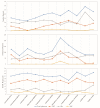Comparative analysis of plastid genomes within the Campanulaceae and phylogenetic implications
- PMID: 32407424
- PMCID: PMC7224561
- DOI: 10.1371/journal.pone.0233167
Comparative analysis of plastid genomes within the Campanulaceae and phylogenetic implications
Abstract
The conflicts exist between the phylogeny of Campanulaceae based on nuclear ITS sequence and plastid markers, particularly in the subdivision of Cyanantheae (Campanulaceae). Besides, various and complicated plastid genome structures can be found in species of the Campanulaceae. However, limited availability of genomic information largely hinders the studies of molecular evolution and phylogeny of Campanulaceae. We reported the complete plastid genomes of three Cyanantheae species, compared them to eight published Campanulaceae plastomes, and shed light on a deeper understanding of the applicability of plastomes. We found that there were obvious differences among gene order, GC content, gene compositions and IR junctions of LSC/IRa. Almost all protein-coding genes and amino acid sequences showed obvious codon preferences. We identified 14 genes with highly positively selected sites and branch-site model displayed 96 sites under potentially positive selection on the three lineages of phylogenetic tree. Phylogenetic analyses showed that Cyananthus was more closely related to Codonopsis compared with Cyclocodon and also clearly illustrated the relationship among the Cyanantheae species. We also found six coding regions having high nucleotide divergence value. Hotpot regions were considered to be useful molecular markers for resolving phylogenetic relationships and species authentication of Campanulaceae.
Conflict of interest statement
The authors have declared that no competing interests exist.
Figures









Similar articles
-
The complete chloroplast genome sequences of three Adenophora species and comparative analysis with Campanuloid species (Campanulaceae).PLoS One. 2017 Aug 22;12(8):e0183652. doi: 10.1371/journal.pone.0183652. eCollection 2017. PLoS One. 2017. PMID: 28829825 Free PMC article.
-
The dynamic history of plastid genomes in the Campanulaceae sensu lato is unique among angiosperms.Proc Natl Acad Sci U S A. 2014 Jul 29;111(30):11097-102. doi: 10.1073/pnas.1403363111. Epub 2014 Jul 14. Proc Natl Acad Sci U S A. 2014. PMID: 25024223 Free PMC article.
-
Substantial structural variation and repetitive DNA content contribute to intraspecific plastid genome evolution.BMC Genomics. 2025 Apr 4;26(1):340. doi: 10.1186/s12864-025-11525-w. BMC Genomics. 2025. PMID: 40186097 Free PMC article.
-
Complete chloroplast genome sequence of Adenophora remotiflora (Campanulaceae).Mitochondrial DNA A DNA Mapp Seq Anal. 2016 Jul;27(4):2963-4. doi: 10.3109/19401736.2015.1060461. Epub 2015 Jun 29. Mitochondrial DNA A DNA Mapp Seq Anal. 2016. PMID: 26119125
-
Plastid genomic features and phylogenetic placement in Rosa (Rosaceae) through comparative analysis.BMC Plant Biol. 2025 Jun 4;25(1):752. doi: 10.1186/s12870-025-06734-0. BMC Plant Biol. 2025. PMID: 40468187 Free PMC article.
Cited by
-
Characteristics of the completed chloroplast genome sequence of Xanthium spinosum: comparative analyses, identification of mutational hotspots and phylogenetic implications.BMC Genomics. 2020 Dec 2;21(1):855. doi: 10.1186/s12864-020-07219-0. BMC Genomics. 2020. PMID: 33267775 Free PMC article.
-
The complete chloroplast genome and phylogenetic analysis of Cyananthus macrocalyx Franch. 1887 Campanulaceae.Mitochondrial DNA B Resour. 2025 May 11;10(6):442-446. doi: 10.1080/23802359.2025.2503403. eCollection 2025. Mitochondrial DNA B Resour. 2025. PMID: 40371129 Free PMC article.
-
The complete chloroplast genome of Onobrychis gaubae (Fabaceae-Papilionoideae): comparative analysis with related IR-lacking clade species.BMC Plant Biol. 2022 Feb 19;22(1):75. doi: 10.1186/s12870-022-03465-4. BMC Plant Biol. 2022. PMID: 35183127 Free PMC article.
-
Phylogenomic insights into Adenophora and its allies (Campanulaceae): Revisiting generic delimitation and hybridization dynamics.Plant Divers. 2025 May 27;47(4):576-592. doi: 10.1016/j.pld.2025.05.010. eCollection 2025 Jul. Plant Divers. 2025. PMID: 40734837 Free PMC article.
-
Chloroplast genomes of four Carex species: Long repetitive sequences trigger dramatic changes in chloroplast genome structure.Front Plant Sci. 2023 Jan 26;14:1100876. doi: 10.3389/fpls.2023.1100876. eCollection 2023. Front Plant Sci. 2023. PMID: 36778700 Free PMC article.
References
-
- Lammers TG. World checklist and bibliography of Campanulaceae. Richmond: Royal Botanic Gardens, Kew; 2007b. pp. 1–675.
-
- Schönland S. Campanulaceae In: Engler A, Prantl K, editors. Die Naturlichen Pflanzenfamilien. Leipzig, IV; 1889. pp. 40–70.
-
- Cellinese N, Smith SA, Edwards EJ, Kim ST, Haberle RC, Avramakis M, et al. Historical biogeography of the endemic Campanulaceae of Crete. J Biogeogr. 2009; 36(7): 1253–1269.
-
- Hong DY, Wang Q. A new taxonomic system of the Campanulaceae s.s.: system of Campanulaceae s.s. J Syst Evol. 2014; 53(3): 203–209.
-
- Lee KJ, You HJ, Park SJ, Kim YS, Jeong HG. Hepatoprotective effects of Platycodon grandiflorum on acetaminophen-induced liver damage in mice. Cancer Lett. 2002; 174(1): 73–81. - PubMed
Publication types
MeSH terms
Substances
LinkOut - more resources
Full Text Sources
Miscellaneous

